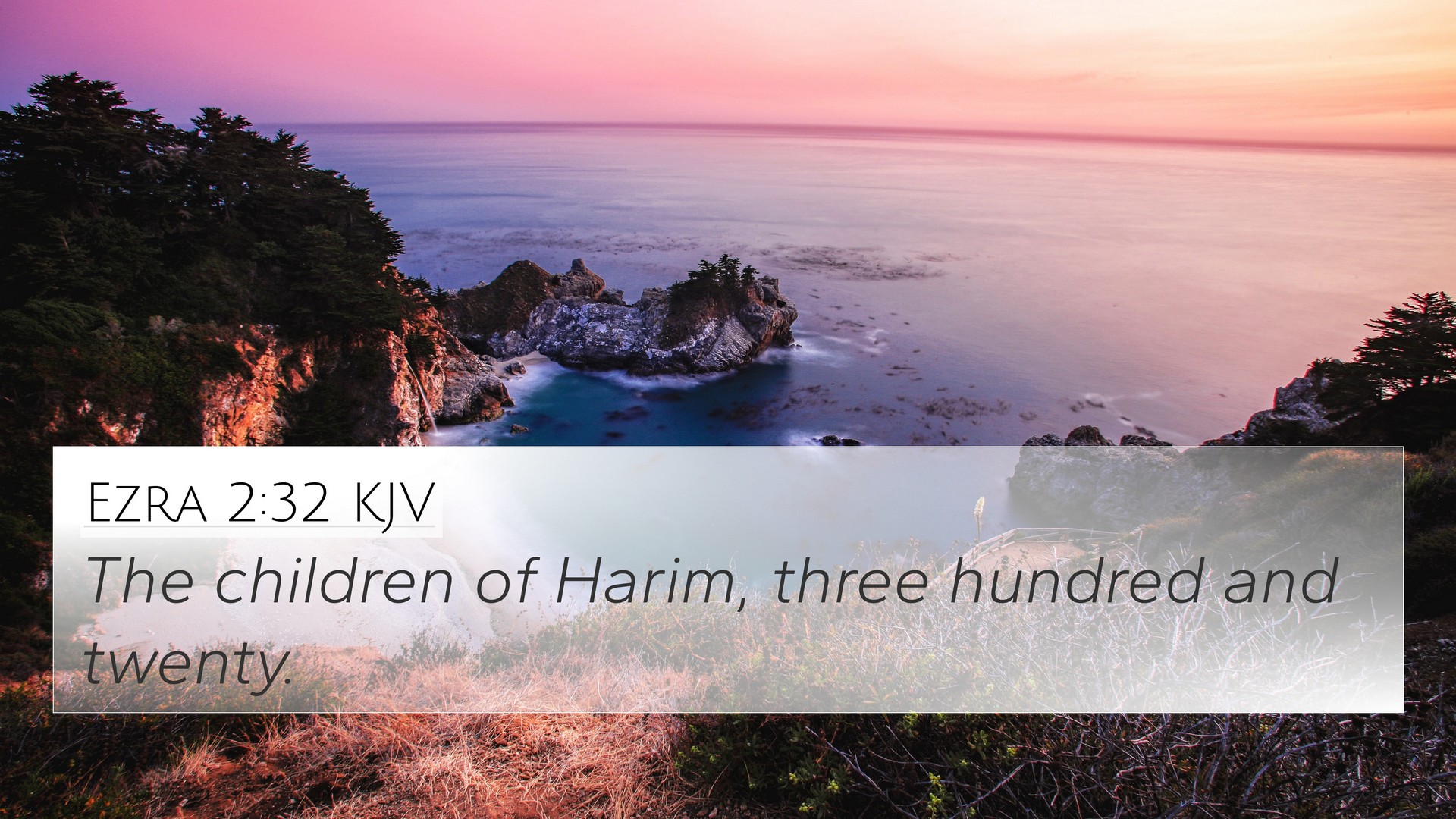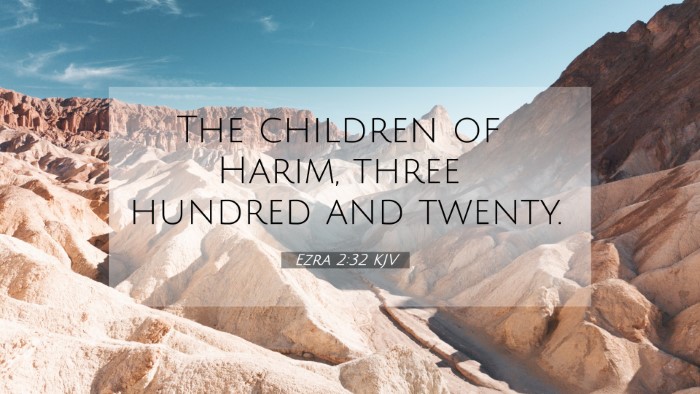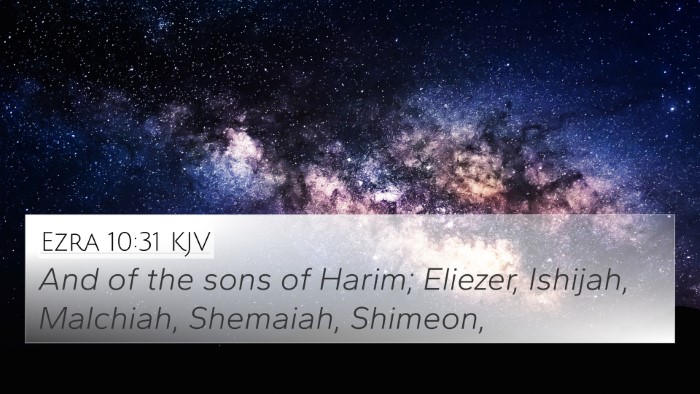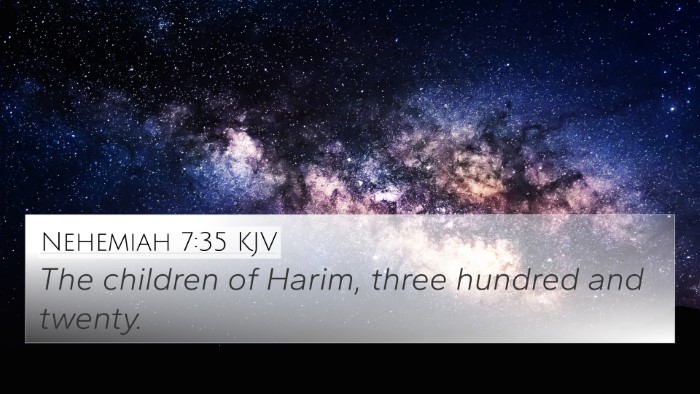Understanding Ezra 2:32
Ezra 2:32 reads: "The children of Harim, three hundred and twenty." This verse is part of a larger context, wherein the returning exiles are listed. The genealogical record serves to authenticate the identity and heritage of the returning Jews after their Babylonian exile.
Significance of Ezra 2:32
This verse not only enumerates a specific group but also highlights the importance of ancestry and belonging in the Jewish culture. Matthew Henry emphasizes that the count from different families underscores the restoration of God's people, returning to their own land and heritage.
Combined Insights from Public Domain Commentaries
In examining the commentaries by Matthew Henry, Albert Barnes, and Adam Clarke, we can synthesize the following key points:
- Identity and Heritage: Each name and family line serves to establish the historical lineage and significance of those returning to Jerusalem.
- Covenantal Importance: The exiles expected to maintain their covenants through the re-establishment of their community. This parallels God's unchanging faithfulness to His people.
- Divine Order: The meticulous nature of their listing reflects God's care for structure and order within His people, indicating that every individual matters in God's redemptive plan.
Bible Verse Cross-References
Connecting Ezra 2:32 to broader biblical themes and narratives provides deeper insight into its meaning. Here are some relevant cross-references:
- Nehemiah 7:26: Another listing of returned exiles, confirming their identity.
- Ezra 2:8: The enumeration of another group returning offers a comprehensive view of the exiles.
- 1 Chronicles 5:29: Highlights the significance of the genealogy in establishing identity.
- Ezra 3:2: Discusses the leadership of the returning exiles, bridging the narrative to their renewed worship.
- Jeremiah 29:10-14: God's promise to the exiles that they would return - linking God's faithfulness to the context.
- Isaiah 44:28: The prophecy concerning Cyrus, emphasizing God’s sovereignty in the return of His people.
- Ezekiel 37:21-22: A prophetic vision of the unification of Israel, resonating with the themes of return and restoration.
- Acts 2:9-11: References to returning Jews in the New Testament, showing continuity in God's people.
- Matthew 1:12-16: Genealogy of Jesus reflecting back on the lineage of the Israelites, showing fulfillment of covenant.
- Revelation 21:12: New Jerusalem described with the names of the tribes, indicating the ultimate restoration and unity of God’s people.
Thematic Connections
Ezra 2:32 acts as a pivotal verse in understanding the broader narrative of restoration and identity among God’s people. Through cross-referencing, we unravel the thematic connections that arise:
- Restoration: This verse reflects the broader theme of God's promise to restore His people after exile.
- Identity and Ancestry: The emphasis on genealogical records highlights the importance of belonging, both culturally and spiritually.
- Covenant Faithfulness: Throughout scripture, God's faithfulness is a key theme showcased through the return of the exiles.
Tools for Bible Cross-Referencing
When exploring such connections, various tools can aid in the process:
- Bible Concordance: Useful for locating verses and understanding terms.
- Bible Cross-Reference Guide: Helps in navigating scriptural connections.
- Cross-Reference Bible Study: A methodical approach to exploring related texts.
- Comprehensive Bible Cross-Reference Materials: Resources that compile extensive cross-references for deeper study.
User Intent and Further Exploration
Readers often seek to understand the connections between biblical verses for various reasons, including personal study, sermon preparation, and academic research. Key inquiries might include:
- What verses are related to Ezra 2:32?
- Find cross-references for this specific verse.
- How do Ezra 2:32 and Nehemiah 7:26 connect?
Conclusion
Ezra 2:32, while a simple enumeration of names, encapsulates profound themes of restoration, identity, and God’s unwavering faithfulness to His people. By engaging with this verse and its myriad connections, believers can gain a more comprehensive understanding of the Biblical narrative and its application to their lives today.




